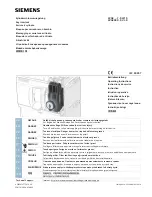
CX6192
C
OMMISSIONING
16
5
Commissioning
5.1
Managing the locking system
The locking system can be managed using the Keyvi management software.
Before a locking system can be used, it has to be personalized and the settings
have to be customized.
5.1.1
personalising
Every door and key in the electronic locking system Clex prime should be known
to the management software for the respective locking system for subsequent
programming. This procedure is called customisation.
During customisation, the door or the cabinet lock installed inside is assigned a
Door ID (D-ID) and the key is assigned a Key ID (K-ID) by the management
software Keyvi.
5.1.2
Changing the settings
The following settings can be changed:
Authorisations (see chapter 3.1.1 Authorisations, page 5)
Time zones (see chapter 3.1.2 Time zone, page 6)
Time
Engagement time (defines the time for which the cabinet lock remains
engaged after holding up an authorised key, see chapter 6.2 Open ,
page 19)
Wake-up sensitivity (see chapter 6.1 Waking up, page 19)
Expiry date of a key (see chapter 3.1.3 Automatic expiry date, page 6)
Radio response of the cabinet lock (wake-on-radio mode)
Advanced cabinet lock settings (see chapter 5.2 Advanced cabinet lock
settings, page 16)
The authorisations have to be changed first in the Keyvi management software for
the individual cabinet locks or groups of cabinet locks. The software consolidates
these settings into tasks, which then need to be transferred first to the service unit
or to ClexTouch. From there, they can be sent to the individual cabinet locks.
If the cabinet lock is located in a Keyvi radio network, then the transfer can also
be done via radio.
For additional information refer to the documentation on CX6530 Keyvi
management software, CX6510 service device, CX6522 ClexTouch and CX6520
programming station.
5.2
Advanced cabinet lock settings
To cover the specific requirements for a cabinet lock, the cabinet lock CX6192
comes with advanced setting options. On the one hand, these are extensions of
the usable key (even unauthorised or keys that are not part of the locking system)
and, on the other hand, those which can open cabinet locks covered by other
keys. The latter is realised using a general priority for the authorised system key
(Clex prime priority) or by setting up a priority group - if neither of these settings is
configured, then the cabinet lock can only be opened using the key which was
used to lock it. In addition, you can also configure a single cabinet restriction
(each key can only open one cabinet lock) and enable the mail box function
(Open and disable the cabinet lock with only a single authorisation operation).









































